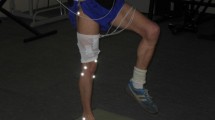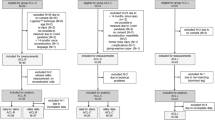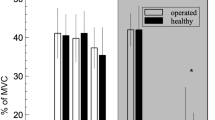Abstract
The aim of this study was to establish whether there are any electromyographic (EMG) differences after two different surgical techniques in two years follow-up after anterior cruciate ligament (ACL) reconstruction. Study participants were divided into three groups. The control group included healthy athletes (C), the first study group (E1) consisted of injured athletes who were treated by ACL reconstruction using patellar tendon graft and the second study group (E2) comprised injured athletes treated by gracilis and semitendinosus tendon graft. The threshold of muscle activity was defined as 30% of maximum amplitude of EMG signal medial envelope of individual muscles in the control group. Two years after reconstruction, the E2 group achieved the maximum amplitude of biceps femoris muscle signal in the takeoff phase statistically significantly later than the E1 group (0.0166, p = 0.05 and 0.015152, p = 0.05/3 = 0.016), whereas the rectus femoris muscle in the flight phase in the E2 group improved statistically significantly earlier than in the C group (0.0393, p = 0.05 and 0.025974, p = 0.05/3 = 0.016). The results of this study show particularly statistically significant differences between observed surgery techniques, which led to the change of the neuromuscular pathway during simple and controlled knee movements even two years after ACL reconstructions in athletes who returned to active training. These disturbances of muscle work coordinations in the knee joint could be tied to the function and location from which the graft was taken rather than the quality of the transplant itself. This may result in an increased risk of repeated knee injury, including potential permanent health consequences in athletes. Based on the results of this research, we were unable to establish which of the presented ACL reconstruction techniques is more appropriate. This study may be useful for athletes and their coaches, who could plan, programme and adequately adjust their training process, thereby improving knee function in the best possible way, which in turn would maintain and extend athletes’ respective sports careers.



Similar content being viewed by others
References
Alentorn-Geli E, Myer GD, Silvers HJ, Samitier G, Romero D, Lázaro-Haro C, Cugt R (2009) Prevention of non-contact anterior cruciate ligament injuries in soccer players. Part 1: Mechanisms of injury and underlying risk factors. Knee Surg Sports Traumatol Arthrosc 17:705–729
Anders JO, Venbrocks RA, Weinberg M (2009) Proprioceptive skills and functional outcome after anterior cruciate ligament reconstruction with a bone-tendon-bone graft. Int Orthop 32:627–633
Bland JM, Altman DG (1995) Multiple significance tests: the Bonferroni method. BMJ 310:170
Bluman AG (2004) Elementary Statistics: a step by step approach. McGraw-Hill, New York
Chouliaras V, Ristanis S, Moraiti C, Tzimas V, Stergiou N, Georgoulis AD (2009) Anterior cruciate ligament reconstruction with a quadrupled hamstrings tendon autograft does not restore tibial rotation to normative levels during landing from a jump and subsequent pivoting. J Sports Med Phys Fit 49:64–70
Columb MO, Sagadai S (2006) Multiple comparisons. Curr Anaesth Crit Care 17:233–236
Dauty M, Tortellier L, Rochcongar P (2005) Isokinetic and anterior cruciate ligament reconstruction with hamstrings or patella tendon graft: analysis of literature. Int J Sports Med 26:599–606
Ejerhed L, Kartus J, Sernert N, Köhler K, Karlsson J (2003) Patellar tendon or semitendinosus tendon autografts for anterior cruciate ligament reconstruction? A prospective randomized study with a two-year follow-up. Am J Sports Med 31:19–25
Gobbi A, Mahajan S, Zanazzo M, Tuy B (2003) Patellar tendon versus quadrupled bone-semitendinosus anterior cruciate ligament reconstruction: a prospective clinical investigation in athletes. Arthroscopy 19:592–601
Hermens HJ, Merletti R, Rix H, Freriks B (eds) (1999) The state of the art on signal processing methods for surface electromyography. Roessingh Research and Development, Enschede
Hermens HJ, Freriks B, Merletti R, Stegeman D, Blok J, Rau G et al (eds) (1999) European recommendations for surface electromyography. Roessingh Research and Development, Enschede
Johnson DS, Smith RB (2001) Outcome measurement in the ACL deficient knee – what's the score? Knee 8:51–57
Kasović M, Medved V, Mejovšek M, Ergović V (2008) Biomechanical diagnostics of knee joint condition in sport. In: Milanović D, Prot F (eds) Proceedings of the 5th International Scientific Conference in Kinesiology. University of Zagreb, Faculty of Kinesiology, Zagreb pp 242–245
Kasović M, Potočanac Z, Mejovšek M (2009) Differences in ACL reconstruction techniques: EMG study. Proceedings of XXII Congress of the International Society of Biomechanics, Cape Town, South Africa (CD-ROM)
Kasović M, Pribanić T, Medved V (2002) Take-off and landing properties in top-level football players: a ground reaction force study. Kinesiology 34:182–189
Katabi M, Djian P, Christel P (2002) Anterior cruciate ligament reconstruction: patellar tendon autograft versus four-strand hamstring tendon autografts. A comparative study at one year follow-up. Rev Chir Orthop Traumatol Revue de chirurgie orthopédique et réparatrice de l'appareil moteur 88:139–148
Kobayashi A, Higuchi H, Terauchi M, Kobayashi F, Kimura M, Takagishi K (2004) Muscle performance after anterior cruciate ligament reconstruction. Int Orthop 28:48–51
Lin Z, Zhang X, Jiang J (2010) Four-strand hamstring tendon autograft versus LARS artificial ligament for anterior cruciate ligament reconstruction. Int Orthop 34:45–49
Mejovšek M, Kasović M, Lončar V (2007) New laboratory test for dynamic satability in ACL deficient knee joint. Program and Abstracts of the XXIth ISB Congress, Taipei, Taiwan, J Biomech 40 (Suppl 2):588
Roe J, Pinczewski LA, Russell VJ, Salmon LJ, Kawamata T, Chew M (2005) A 7-year follow-up of patellar tendon and hamstring tendon grafts for arthroscopic anterior cruciate ligament reconstruction: differences and similarities. Am J Sports Med 33:1337–1345
Seon JK, Song EK, Bae BH, Park SJ, Yoon TR, Cho SG, Lee JJ, Kim MS (2007) Kinematic study following double-bundle, anterior cruciate ligament reconstruction. Int Orthop 31:623–628
Spindler KP, Kuhn JE, Freedman KB, Matthews CE, Dittus RS, Harrell FE Jr (2004) Anterior cruciate ligament reconstruction autograft choice: bone-tendon-bone versus hamstring: does it really matter? A systematic review. Am J Sports Med 32:1986–1995
Taylor DC, Deberardino TM, Nelson BJ, Duffey M, Tenuta J, Stoneman PD, Sturdivant RX, Mountcastle S (2009) Patellar tendon versus hamstring tendon autografts for anterior cruciate ligament reconstruction: A randomized controlled trial using similar femoral and tibial fixation methods. Am J Sports Med 37:1946–1957
Tow BP, Chang PC, Mitra AK, Tay BK, Wong MC (2005) Comparing 2-year outcomes of anterior cruciate ligament reconstruction using either patella-tendon or semitendinosus-tendon autografts: a non-randomised prospective study. J Orthop Surg (Hong Kong) 13:139–146
Woo SL, Fisher MB (2009) Evaluation of knee stability with use of a robotic system. J Bone Joint Surg 91(Suppl 1):78–84
Acknowledgements
This study was supported by the Ministry of Science, Education and Sports of the Republic of Croatia (Project No. 034-0362979-2334 and 034-0000000-2340)
Author information
Authors and Affiliations
Corresponding author
Rights and permissions
About this article
Cite this article
Kasović, M., Mejovšek, M., Matković, B. et al. Electromyographic analysis of the knee using fixed-activation threshold after anterior cruciate ligament reconstruction. International Orthopaedics (SICOT) 35, 681–687 (2011). https://doi.org/10.1007/s00264-010-1050-4
Received:
Revised:
Accepted:
Published:
Issue Date:
DOI: https://doi.org/10.1007/s00264-010-1050-4




